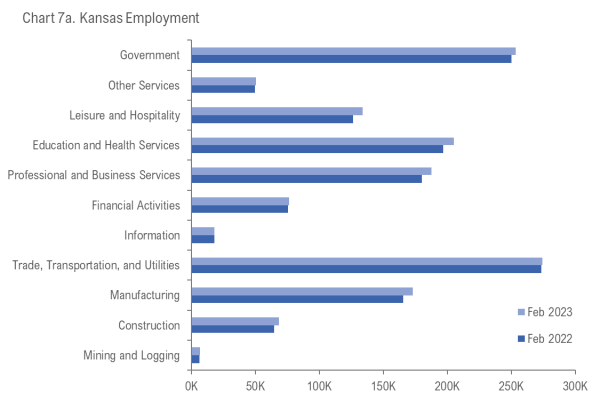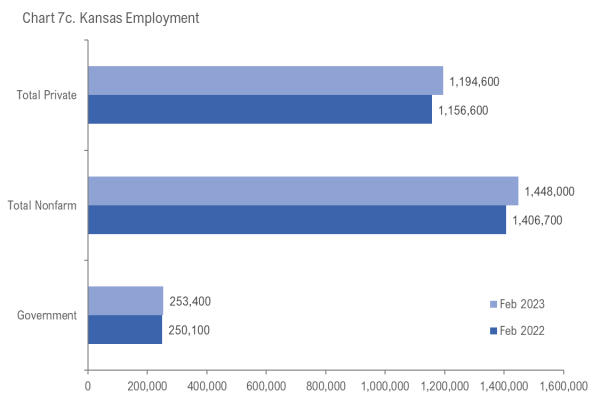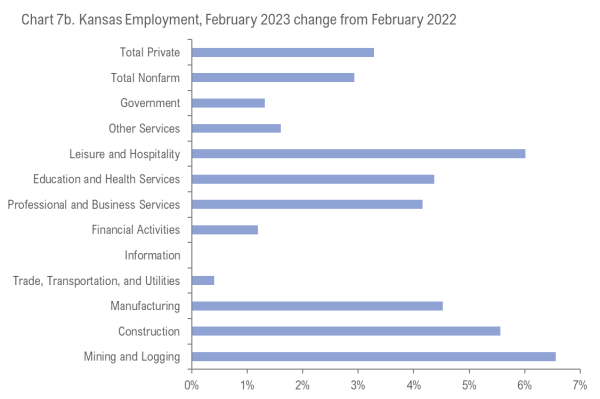In Kansas for February 2023, the labor force grew, the number of jobs fell, and the unemployment rate was unchanged, all compared to the previous month. Over the year, Kansas is above the middle of the states in job growth.
Data released from the Bureau of Labor Statistics, part of the United States Department of Labor, shows a mostly unchanged employment picture in Kansas for February 2023 when compared to the previous month.
Of special note this month: Considering year-over-year nonfarm job growth, Kansas no longer has the lowest value in the nation, as it had in some months last year. Now Kansas is in the top quarter of the states.
(Click charts and tables for larger versions.)
Using seasonally adjusted data, from January 2023 to February 2023, nonfarm employment in Kansas rose by 1,500 jobs (0.1 percent). Over the year, the number of Kansas nonfarm jobs for February 2023 was higher by 41,300 (2.9 percent) over the same month last year. This is using seasonally adjusted data.
Over the year (February 2022 to February 2023), the Kansas labor force rose by 9,160 people (0.6 percent) using seasonally adjusted data from the household survey, with an increase of 2,389 (0.2 percent) over the last month.
There are now 177,300 (11.8 percent) more jobs in Kansas than in April 2020, which is the low point since the pandemic’s start. There are 18,900 (1.3 percent) more jobs than in February 2020, just before the pandemic. These are counts of nonfarm jobs with employers in Kansas, without regard to the residence of the employee. Considering employed people from the household survey, there are now 154,863 (11.8 percent) more working people in Kansas than in April 2020, and 7,860 (0.5 percent) more than in February 2020. The household survey counts Kansas residents with nonfarm jobs, without regard to the location of the job.
The number of unemployed persons rose from January 2023 to February 2023 by 417 persons (1.0 percent). The unemployment rate was 2.9 percent in February 2023, unchanged from the previous month, and up by 0.5 percentage points over the year.
Comparing Kansas to the nation: Using seasonal data, the number of Kansas nonfarm jobs is 2.94 percent higher than 12 months ago, while nationally, the same statistic is 2.87 percent higher. Non-seasonal data shows the number of Kansas nonfarm jobs is 3.11 percent higher than 12 months ago, while nationally, the same statistic is 2.91 percent higher.
To learn more about this data and what the employer and household surveys measure, see Visualization: Employment measures. Also, see Counting jobs in Kansas.
Click charts and tables for larger versions.
Chart 3 shows job changes for Kansas and the nation from the previous month, and we can see positive changes for Kansas over the past year except for two months, including February 2023.
Chart 4a shows job changes for Kansas and the nation from the same month one year ago. In recent months, the growth in Kansas has been similar to the nation.
In Chart 5, showing unemployment rates for Kansas and the nation, we see that the rate in Kansas is lower than the national rate, as it had been before the pandemic. The unemployment rate in Kansas is little changed over the last six months. The difference between the Kansas unemployment rate and the national rate has become smaller.
Chart 6 shows monthly changes in the labor force for Kansas and the nation. The Kansas labor force has both expanded and contracted since the pandemic, as has the national labor force. The monthly changes for both are mostly small over the year.
For industry groups, the following charts (7a and 7c) show the number of employees in various industries in December 2021 and December 2022.
Chart 7b uses the same data but shows the percent change from December 2021 to December 2022. All industry groups have gains except for Information, which was unchanged.
The rate of job growth in Kansas over the year had been lowest in the nation for some months of 2022. In October 2022, Kansas rose to the middle, ranking twenty-seventh among the states and the District of Columbia. In December, the rank was twentieth, in January, eleventh, and now, twelfth. This high ranking is despite a small loss in jobs in February The following chart shows the monthly and annual change in the number of jobs in the states, along with the rank of the state.
The report for this month from the Kansas Department of Labor is here. The report from BLS may be found here. It appears there are no news releases or social media posts from Governor Kelly on this topic.














Leave a Reply